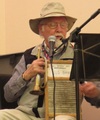Death With Dignity
From Rendered | Part of the Destination DIY series | 17:46
Julie Sabatier interviews Dr. Peter Goodwin, who was instrumental in creating Oregon's "Death with Dignity" law (sometimes referred to as "assisted suicide"). Dr. Goodwin himself used the law to end his own life a short time after the interview was recorded.
- Playing
- Death With Dignity
- From
- Rendered
 This interview originally appeared in the Conversations episode of Destination DIY. The full episode is also available on PRX.
This interview originally appeared in the Conversations episode of Destination DIY. The full episode is also available on PRX.
Producer is Julie Sabatier (suh-BAH-tee-ay)
Collaborating with the Mystery
From Mary Quintas | 07:41
Bud Brown is known for singing Iris DeMent's "Let the Mystery Be". A few years ago, his relationship to the song changed: Bud's wife became terminally ill, and she asked him to sing it at her memorial service.
- Playing
- Collaborating with the Mystery
- From
- Mary Quintas

Stories1st: Elizabeth and Her Family
From Dmae Lo Roberts | 05:08
A day in the life of 11-year-old Elizabeth Herrera. THERE ARE TWO VERSIONS OF THIS SHOW DEPENDING ON HOW YOU WANT TO RUN IT.
- Playing
- Stories1st: Elizabeth and Her Family
- From
- Dmae Lo Roberts
 Elizabeth Herrera moved with her family to Portland, Oregon two years ago. Shortly after moving, her father died and the family became homeless. Her mother goes to English classes most of the day and her 17 year old sister is pregnant, leaving Elizabeth to translate and watch over the family. This is a short slice of life during one day with Elizabeth and her family. First aired on NPR's LatinoUSA and part of Stories1st.org Summer Special called Growing Up, Growing Strong.
Elizabeth Herrera moved with her family to Portland, Oregon two years ago. Shortly after moving, her father died and the family became homeless. Her mother goes to English classes most of the day and her 17 year old sister is pregnant, leaving Elizabeth to translate and watch over the family. This is a short slice of life during one day with Elizabeth and her family. First aired on NPR's LatinoUSA and part of Stories1st.org Summer Special called Growing Up, Growing Strong.
THERE ARE TWO VERSIONS OF THIS SHOW DEPENDING ON HOW YOU WANT TO RUN IT.
1970s Black Rock, or the Ties that Bind
From WBEZ | Part of the Vocalo Presents series | 08:18
Recently at Chicago’s Music Box Theatre, Ayana Contreras caught a documentary about Death, a 1970s all-black proto-punk band out of Detroit. The documentary, titled “A Band Called Death” chronicled the group’s forming, brush with success, and descent into obscurity.
It may have been unusual to be an all-black rock band in Motown; but it wasn't the anomaly that it might at first appear to be.
- Playing
- 1970s Black Rock, or the Ties that Bind
- From
- WBEZ

Recently at Chicago’s Music Box Theatre, Ayana Contreras caught a documentary about Death, a 1970s all-black proto-punk band out of Detroit. The documentary, titled “A Band Called Death” chronicled the group’s forming, brush with success, and descent into obscurity. The master tapes of their sole album, recorded under Don Davis’ Groovesville productions languished in an attic for over thirty years. That is until a perfect storm of record collectors resurrected the work, resulting in a New York Times article, a reissue, and a tour.
It may have been unusual to be an all-black rock band in Motown; but it wasn't the anomaly that it might at first appear to be.
The Art of De-Extinction
From Britt Wray | 06:28
A group of scientists are now trying to bring extinct animals - like the woolly mammoth and passenger pigeon - back to life, in a movement called De-Extinction. But there's much more to it than biotechnology. The entire idea has an art to it. One painter, Isabella Kirkland, is making work that touches on the philosophy at the center of it all.
- Playing
- The Art of De-Extinction
- From
- Britt Wray
 The description below is taken from WNYC's Studio 360 with Kurt Anderson, where the piece originally aired. http://www.studio360.org/story/307026-de-extinction/
The description below is taken from WNYC's Studio 360 with Kurt Anderson, where the piece originally aired. http://www.studio360.org/story/307026-de-extinction/
Bringing extinct animals back has usually been left to the world of science fiction. But a group of biologists is attempting it in the real world. The organization Revive & Restore , a project of the Long Now Foundation, held a day-long TEDx conference on de-extinction a few months ago at the National Geographic Society. This is not quack science; some of the research involves Harvard University, UC Santa Cruz, and Wake Forest University, among other institutions.
Painter Isabella Kirkland , who is also a research associate at the California Academy of Sciences, opened the event with an image of her painting Gone . It looks like a Dutch master’s oil painting, depicting 63 extinct New World species arrayed on a table elegantly: the Carolina parakeet, the golden toad, and in the central place of honor, Martha, the last passenger pigeon , who died in 1914.
The passenger pigeon is the preoccupation of Revive & Restore’s Ben Novak , a genetic biologist. “It’s my job to bring the bird back to life.” Novak began thinking about resurrecting animals in junior high school, when he did a science fair project on the dodo bird. “It’s the icon of extinction — ‘dead as a dodo,’ as they say — and I learned that the dodo is actually a giant extinct pigeon. It gave me the pigeon bug.” The techniques are complicated and untried, but de-extinction is simple in concept: take DNA from a dead sample in a natural history museum somewhere, and plant it in the egg of a living relative — in this case, the band-tailed pigeon. If it works, the living bird will hatch an egg out of which will come the clone of a long-dead bird.
But many scientists are skeptical of or opposed to this so-called Great Comeback. David Ehrenfeld , a conservation biologist at Rutgers University, points out that bringing back a few examples of a species won’t have much of an effect on the diversity of our ecosystem — especially a species that lived in massive flocks like the passenger pigeon. Meanwhile, resources will be directed to a flashy, high-tech project, as conservationists count the living species dying off year after year.
If the de-extinction of the passenger pigeon works, and the species is somehow reintroduced into the wild, perhaps Isabella Kirkland will retouch her painting Gone , substituting some other photogenic animal in pride of place. Perhaps the critically endangered Sumatran rhino? There are, and will continue to be, a wealth of candidates .Ediacaran Fauna Fossils ~ Funisia dorothea and Dickinsonia
From Atlantic Public Media | Part of the One Species at a Time ~ The Encyclopedia of Life series | 05:41
Strange denizens of the primordial slimebed; for example Dickinsonia rex, a sort of living bathmat without eyes or a mouth...

